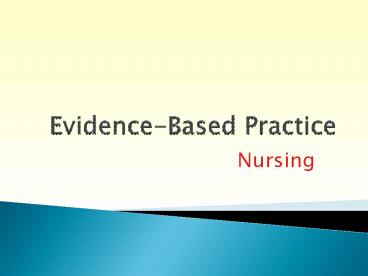EvidenceBased Practice PowerPoint PPT Presentation
1 / 22
Title: EvidenceBased Practice
1
Evidence-Based Practice
- Nursing
2
Training in EBP for Nurses
- Advantages
- Ensure that patients receive best care.
- Mechanism to improve the quality of care.
- Part of change management within the
organisation. - Nursing Professional Development.
- Enhance communication with other health
professionals.
3
Strategies for Teaching EBP to Nurses
- Train the Trainers in EBP
- Introduction within under-graduate training and
graduate year programs. - Formulating research questions introduced within
specific clinical contexts - Computer searching and accessing evidence-based
research introduced with the clinical ward
environment.
4
Short-course Introduction to EBP.
- Train the Trainers
- Introduction to the principles of EBP
- Formulating questions in a PICO format
- Database Searching
- MeSh Heaings
- Medline
- Cochrane
- Cinahl
- Introduction to systematic reviews,
meta-analysis. - Introduction to Evidence-Based Guidelines.
5
Problems with EBP training
- Perceived as too time-consuming
- Question
- Applicability
- Relevance
- Practicality
- Nurses may not feel that they are in a position
to change practice within their ward. - Perception that robust high-level evidence for
nursing interventions does not exist.
6
Educational Strategies
- Train Nurses in Educational Leadership Roles.
- Incorporate summaries of the evidence into tools
and documentation currently used within the ward
area. - Need for tool-kits that summarise the evidence.
- EG Delirium Management Guidelines
- Incorporate into educational sessions given to
graduate year nurses.
7
Need for Organisational Support for
Implementation ofEvidence-Based Care
- Example
- Non-invasive ventilation for management of
hypercapnic respiratory failure secondary to
exacerbation of COPD. - Level II Evidence
- Safe alternative to Critical Care,
- Cost-effective,
- Decreased inpatient mortality.
- Keenan, S. 2003 Annuals of Internal Medicine,
- Plant, PK. 2003 BMJ.
8
Respiratory Care Unit
- Not used at RMH outside critical care / high
acuity beds before Sept 2004. - Lack of staff expertise.
- Lack of equipment.
- No specialised beds
- Perception that use of NIV in general ward areas
would be unsafe. - Opening Respiratory Care Unit to provide an
environment in which - Non-invasive Ventilation could be used outside
high-dependency areas.
9
EBP and Quality Improvement
- EBP as part of the Quality Improvement Cycle
- Acknowledgement of projects that have improved
practice quality of care. - Raise awareness that implementation of high
quality care is about implementing current
evidence.
10
Oxygen Therapy in Hypercapnic COPD patientsWhy
is this still a problem?How do we close the
quality and safety loop?
11
System change
- Staff Education Program
- Patient Empowerment
- Identification of CO2 retainers
- Alert at ED triage, Second screen in ED and
clinical pway - Alert in front of history
- Coloured arm band in hospital
- Sign over bed
- Written oxygen order on RCU forms
- ?prescription of O2
- All patients with lung disease and ?CO2 reported
to resp reg or CNC for resp med.
12
Re-evaluation
- Repeat audit next year
- Hope to demonstrate ongoing change
- Important to demonstrate that implementation of
evidence-based best practice requires input from
all members of the multi-disciplinary team. - One mechanism to increase a sense of ownership
and involvement in improving care.
13
EBP and Advanced Nursing Roles
- Development of Clinical Nurse Consultant and
Clinical Nurse Practitioner Roles within the
organisation. - Need for focused interventions that improve
patient outcomes. - Need for interventions to be cost-effective.
14
Development of Advanced Practice Roles
- Based upon systematic review of the literature.
- Identification of current best practice and
evidence. - Identification of gaps in the evidence.
- Support to formulate research to address gaps in
the evidence.
15
(No Transcript)
16
(No Transcript)
17
Summary
- World-wide EBP Education for Nurses is becoming
standard practice. - Need for EBP to become part of the nursing
culture at Melbourne Health. - Need for Applied Evidence for Nursing
Interventions to be readily available in the
clinical setting. - Need for greater support for senior nurses to
contribute to the development of evidence based
practice for nurses.
18
Evidence for Nursing Practice
- Nursing Literature
- Qualitative Quantitative Research
- Evidence-Based Clinical Practice Guidelines
- Medical Scientific Literature
19
Interventions for Chronic Conditions
Controlled chronic disease
Established disease
Disease management and 3o prevention
Optimise HRQoL
Prevent acute exacerbations
Continuing care Maintenance Rehabilitation Self-
management
Treatment Management of complications
Specialist services Hospital care Primary care
Primary care Community care
Health Promotion
Health Promotion
N Spearing. University of Queens land
20
Evaluating Program Effectiveness
.................Measuring Outcomes
- Individual Client outcomes
- Behavioural change
- Changes in quality of life
- Client carer satisfaction
- Systems-Based outcomes
- Re-admission rates
- Inpatient Length of Stay
- Adherence with follow-up
- Health Economic outcomes
- Cost-effectiveness
- Models of Cost Reduction
21
(No Transcript)
22
(No Transcript)

